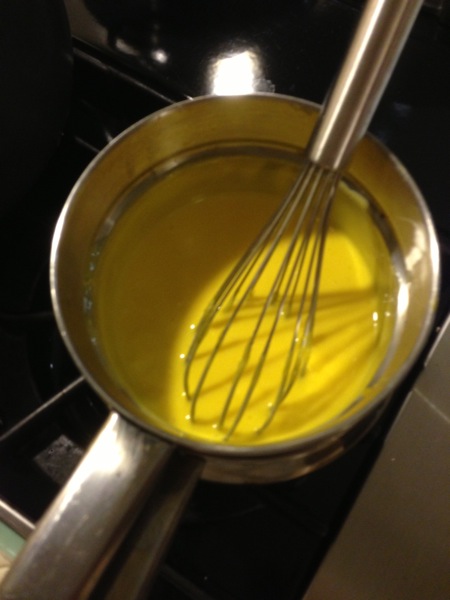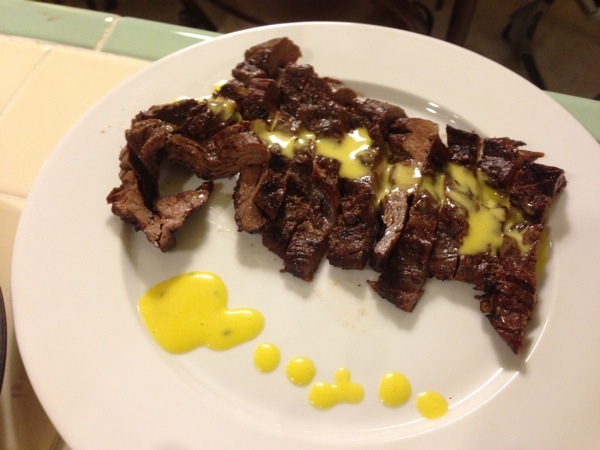Cream of Cauliflower Soup with Red Beet Chips
- 2 heads cauliflower (4 to 5 pounds total)
- 4 tablespoons (2 ounces) unsalted butter
- ¾ cup coarsely chopped onion
- ¾ cup coarsely chopped leeks (white and light green parts only)
- ¼ teaspoon Yellow Curry Powder or Madras curry powder
- Kosher salt
- 2 cups milk
- 2 cups heavy cream
- 2 cups water
- Peanut or canola oil for deep-frying
- 1 medium beet
- 1 teaspoon distilled white vinegar
- Torn Croutons (see belwow)
- Extra virgin olive oil
- Fresh ground pepper
The unctuous, velvety, creamy texture of this soup is so elegant and satisfying. Curry offsets the richness and cauliflower florets, croutons, and beet chips give the soup some body and crunch.
Remove the leaves from the cauliflower, and cut out the core. Trim off the stems and reserve them. For the garnish, trim 2 cups florets about the size of a quarter and set aside.
Coarsely chop the remaining cauliflower and the stems into 1-inch pieces so that they will cook in the same amount of time. You need 8 cups of cauliflower (reserve any extra for another use).
Melt 3 tablespoons of the butter in a large saucepan over medium heat. Add the onion, leeks, curry, and coarsely chopped cauliflower, season with 2 teaspoons salt, cover with a parchment lid,
Pour in the milk, cream, and water, increase the heat to medium high, and bring to a simmer. Simmer for 30 minutes, skimming off the foam from time to time.
Working in batches, transfer the cauliflower mixture to a Vita Mix (leave an opening in the lid for the steam to escape). Begin pureeing the cauliflower on the lowest speed and blend, slowly increasing the speed, until smooth and velvety. Check the seasoning and add more salt if needed. Transfer to a large saucepan and keep warm. (The soup can be refrigerated for up to 2 days.)
Fill a small deep pot with 1 inch of peanut oil and heat over medium heat to 300 degrees F. Set a cooling rack over a baking sheet. Line the rack with paper towels.
While the oil heats, peel the beet and slice off about ½ inch from the top. Using a Japanese mandolin or other vegetable slicer, slice the beet into rounds that are slightly thicker than paper-thin. Reserve only the full rounds.
Carefully add a few beet rounds to the oil and fry, turning them with a wire skimmer or slotted spoon as the edges begin to curl and pressing gently on the chips to keep them submerged. You will see a great deal of bubbling around the beets as the moisture in them evaporates; when the bubbling stops, after 1 to 1 ½ minutes, the beets will be crisp. Transfer the beets to the paper-towel-lined rack and season with salt. Fry the remaining chips in batches. The chips can be kept warm in a low oven.
Bring a medium saucepan of salted water to a boil. Add the vinegar and the reserved cauliflower florets and blanch until tender, 4 to 6 minutes. The vinegar will help keep the cauliflower white. Drain.
Melt the remaining 1 tablespoon butter in a medium frying pan over medium-high heat, swirling the pan occasionally, until the butter turns a rich golden brown. Add the florets and sauté until a rich golden brown. Set aside.
Pour the soup into a serving bowl or soup tureen. Top each serving with a few cauliflower florets, several torn croutons, and a stack of beet ships. (If the beet chips sit in the soup, they will be come soggy and discolor it.) Drizzle with olive oil and sprinkle with pepper. Serve the remaining florets, croutons, and chips in separate bowls on the side.
SERVES 6 (MAKES ABOUT 2 QUARTS)
(Page 127)
Torn Croutons
- 1 loaf country bread
- Garlic Oil (see below)
- 2 tablespoons (1 ounce) unsalted butter
Cooking the torn pieces of bread very, very slowly is the key to these garlicky croutons. When toasted over high heat, croutons become a little dry; these absorb the oil and butter through the slow cooking, and the result is croutons that are very crunchy but bursting with the flavor of the oil when you bite into them. We serve these in many salads.
Cut the crusts off the loaf of bread. Tear the bread into irregular pieces no larger than 2 inches. You need about 3 cups of croutons; reserve any remaining bread for another use.
Pour 1/8 inch of the garlic oil into a large sauté pan and heat over medium heat until hot. Spread the bread in a single layer in the pan (if your pan is not large enough, these can be cooked in two smaller pans). Add the butter. The oil and butter should be bubbling, but if you hear sizzling, the heat is too high. Adjust the heat as necessary, and stir the croutons often as they cook. Cook until the croutons are crisp and a beautiful rich golden brown on all sides, 15 to 20 minutes. Move the croutons to one side of the pan and keep warm until ready to serve. (Do not drain on paper towels; you want the flavors of the oil intermingled with the other ingredients as you eat the croutons in a salad.) Torn croutons should be used the day they are made; you can reheat them in a low oven before serving if necessary.
MAKES 3 CUPS
Note: If you don’t have any garlic oil on hand, pour 1/8 inch of canola oil into a sauté pan, add 5 crushed, peeled garlic cloves, and heat over low heat until the garlic cloves are golden brown, flipping the cloves from time to time. Remove the garlic cloves and use the oil for the croutons.
(Page 274)
Garlic Confit and Oil
- 1 cup peeled garlic cloves
- About 2 cups canola oil
Cut off and discard the root ends of the garlic cloves. Put the cloves in a small saucepan and add enough oil to cover them by about 1 inch – none of the garlic cloves should be poking through the oil.
Set the saucepan on a diffuser over medium-low heat. The garlic should cook gently: very small bubbles will come up through the oil, but the bubbles should not break the surface; adjust the heat as necessary and/or move the pan to one side of the diffuser if it is cooking too quickly. Cook the garlic for about 40 minutes, stirring every 5 minutes or so, until the cloves are completely tender when pierced with the tip of a knife. Remove the saucepan from the heat and allow the garlic to cool in the oil.
Refrigerate the garlic in a covered container, submerged in the oil, for up to 1 week.
MAKES 1 CUP
(Page 266)
Source: Thomas Keller Ad Hoc At Home – Family Style Recipes (Artisan)

























